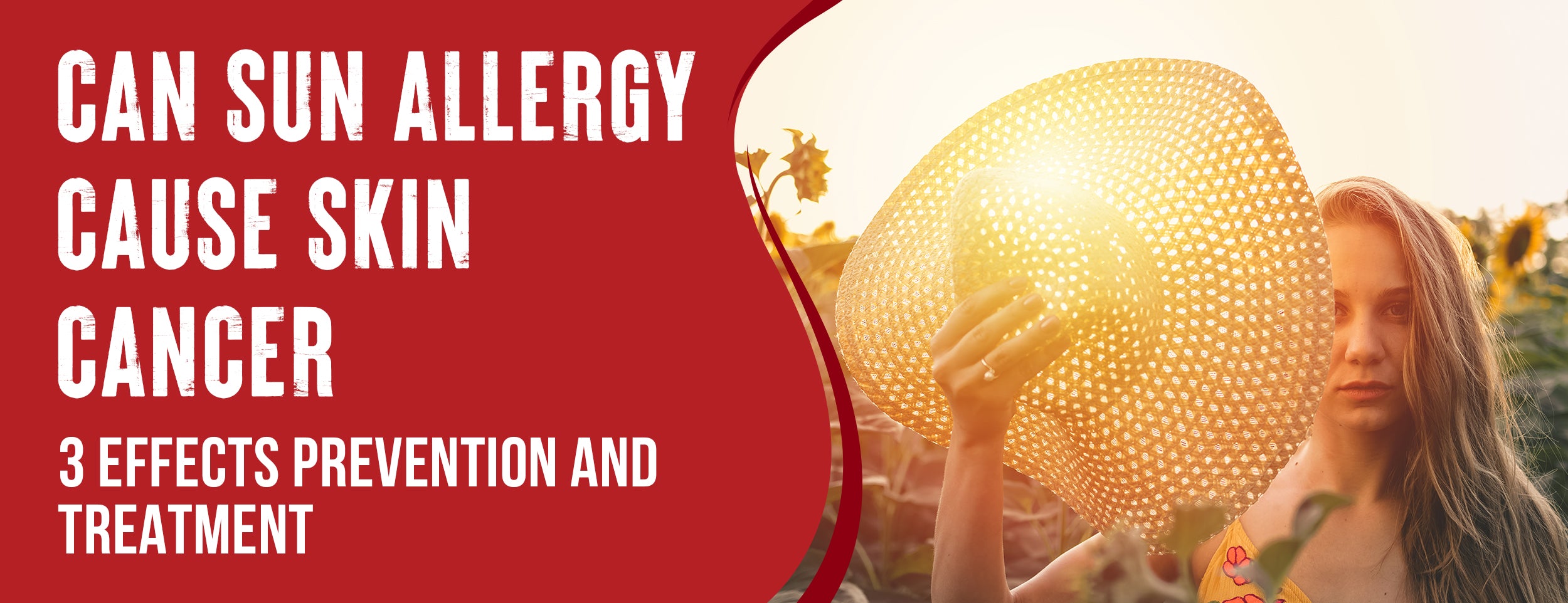An allergic reaction to sunlight causes a rash. Sun allergy can cause dehydration and irritation because of excessive sweating and fluid loss. If blisters or open sores resulting from sun allergy are not adequately cared for, they can become infected.
For treating sun allergy rash, antihistamines such as loratadine, fexofenadine, and cetirizine, corticosteroids like prednisone, creams to ease itchiness, omalizumab injections, and phototherapy are recommended.
In this blog post, we will explain practical methods for treating sun allergy rashes and the best ways to prevent sun allergy rashes.
Sun Allergy Rash Treatment: 3 Methods

Dealing with a sun allergy rash can be challenging. Treatment options that can ease symptoms and make your life easier are available. These are some of the home and medication treatments you can try.
Diagnosis and Tests
Getting a diagnosis is the first step if you have a sun allergy. Your healthcare provider can diagnose sun allergies by examining your skin and possibly ordering tests. Here's what you need to know.
Consultation with Your Healthcare Provider
If you suspect a sun allergy, talking to a healthcare provider or dermatologist is essential. They can diagnose the condition based on several factors:
- A discussion about your symptoms.
- A review of any medications you take and products you apply to your skin.
- Patch testing, where patches containing certain chemicals are applied to your skin to check for reactions.

Ultraviolet (UV) Light Testing
Also known as photo testing, this test checks how your skin reacts to light from a unique lamp. It can help identify the type of sun allergy you have. Here's how it works:
- You'll be exposed to different amounts of UVA and UVB light.
- The doctor will observe how your skin reacts.
- This reaction helps determine if you're allergic to sun and, if so, what type.
Photo patch Testing
Photo patch testing helps determine if your sun allergy is caused by a substance sensitizing your skin to sunlight. Here's what happens during this test:
- Patches containing common sun allergy triggers apply to your skin, typically on your back.
- One patch is exposed to UV light from a unique lamp a day later.
- If you react only in the area exposed to light, it's likely linked to the substance being tested.
Blood Tests and Skin Samples
Sometimes, your symptoms might be caused by an underlying condition, like lupus. A healthcare provider may request blood tests or skin samples in such cases. These involve:
- Taking a small amount of blood or skin for lab testing.
- Examining the samples to check for signs of lupus or other conditions.
Over-The-Counter Treatment Option

Sun allergy can be treated most effectively by avoiding sun exposure. Some treatments may help those who can't avoid the sun or have extreme reactions to it:
Antihistamines: The First Line of Defense
Antihistamines are often the first treatment option for sun allergy rashes. These medicines block histamine, a chemical in your body that causes allergy symptoms. Some common over-the-counter antihistamines include:
- Loratadine: This non-drowsy antihistamine can relieve symptoms like itching and redness.
- Fexofenadine: Another non-drowsy option that works to reduce inflammation and discomfort.
- Cetirizine: While it can sometimes cause drowsiness, cetirizine is effective at alleviating itchiness and swelling.
- Remember, checking with your doctor before starting any new medication is always a good idea.
Corticosteroids: Reducing Inflammation and Itchiness
Corticosteroids are another standard treatment for sun allergy rash. They reduce inflammation and can be applied directly or orally to the skin.
Some popular corticosteroids include hydrocortisone and prednisone. These powerful drugs can offer rapid relief, but they should only be used under the guidance of a healthcare provider because of potential side effects.
Topical Creams: Soothing the Skin
Topical creams can also be beneficial for easing the itchiness associated with sun allergy rash. These creams, often containing aloe vera or calamine, provide a soothing effect on the skin and help to reduce inflammation. Always test a small amount of cream on a skin patch first to avoid an adverse reaction.

Omalizumab Injections: A Newer Option
Doctors may recommend a treatment called omalizumab for severe cases of sun allergy. This type of injection works by blocking the immune system's response to allergens. While this is a more advanced treatment option, it can be very effective for those with severe sun allergies.
Phototherapy: Building Skin’s Tolerance to Sunlight
Phototherapy, or light therapy, is a long-term treatment option for sun allergies. In this technique, you expose your skin to small amounts of artificial sunlight to build up the skin's tolerance. Over time, this can reduce the severity of reactions to sun exposure.
Here's how it typically works:
- Initial Consultation: Your doctor will evaluate your condition and determine if phototherapy suits you.
- Treatment Sessions: You'll have regular sessions where specific areas of your skin are exposed to ultraviolet (UV) light.
- Monitoring Progress: A physician will monitor your progress and adjust your treatment plan as needed.
Home Remedies For Sun Allergy Rashes

Sun allergy rashes can be uncomfortable and frustrating. But don't worry, several home remedies can help soothe your skin and relieve symptoms. Let's explore some of these methods.
Milk and Quark
Try these remedies to ease discomfort caused by skin rashes. First, soak a clean cloth in cool milk and apply it to the affected area. The coolness of the milk can help soothe the skin, while the milk's proteins can help reduce inflammation.
Second, a layer of quark should be applied directly to the rash. Like milk, quark has cooling and anti-inflammatory properties that can help ease discomfort.
Cold Compress
Cold compresses are effective for sun allergy rashes. It can reduce swelling and relieve irritation. Ice cubes are great for inflammation. Wrap one in a clean cloth and apply it to the inflammation. Ice should never be used directly on the skin, which may cause frostbite.
Cucumber Puree
Cucumbers have cooling properties, which makes them ideal for treating sun allergy rashes. To make a cucumber puree:
- Peel and blend a fresh cucumber.
- Apply the puree directly to the inflammation.
- Leave it on for 15-20 minutes before rinsing with cool water.

Black Tea
Tea's tannic acid reduces sunburns and other skin irritations. Brew a robust black tea, let it cool, and then apply it to the rash using a clean cloth. You can also soak in a bath with several black tea bags for relief.
Sun Allergy Rash Prevention: 7 Tips
While treating sun allergy rashes is essential, preventing them in the first place is even better. Simple precautions can protect your skin and decrease the occurrence of sun rashes. The following tips can help you prevent disease:
Choose the Right Sunscreen
Sunscreen is your first line of defense against harmful UV rays. But not all sunscreens are made equal. To effectively protect your skin:
- SPF protects you from UVA and UVB.
- Wear sunscreen with an SPF of at least 50.
- Apply sunscreen every two hours to all exposed areas of your skin. Remember, often-overlooked areas like your ears and the back of your neck.
Dress for Protection
What you wear can also help shield your skin from the sun's rays. When heading outdoors, consider:
- Wear sun-protective clothing designed to block UV rays. This can include items like long-sleeved shirts, pants, and broad-brimmed hats.
- Choosing clothes in dark colors or with tight weaves can provide better protection against UV rays.
Be Mindful of the Sun's Peak Hours

Take a break from the sun between 10 a.m. to 4 p.m. During these hours, try to:
- Stay indoors or seek shade.
- If you must be outside, shade your skin from direct sunlight.
Gradually Increase Sun Exposure
You may be more sensitive to the sun at the start of spring and summer. To help your skin adapt:
- Gradually increase the time you spend in the sun.
- Start with short periods of exposure and slowly build up.
Avoid Photosensitizing Medications and Products
You can make your skin more sensitive to sunlight with some medications. If you think a product or medicine might cause your sun allergy:
- Stop using the product or consult with your healthcare provider about alternative medications.
Use Protective Items
There are several products available that can provide extra protection against the sun's rays:
- Consider wearing wide-brimmed hats, long sleeves, and pants when out in the sun.
- Use window films on your car and home windows to block UV rays.

Reapply Sunscreen Regularly
Even the best sunscreen won't provide all-day protection. To keep your skin safe:
- Reapply sunscreen every two hours.
- Apply more frequently if you're sweating or swimming.
Conclusion
Your sunny days will be ruined if you get a sun allergy rash. But remember, it's a treatable condition, and you're not alone. From antihistamines and topical creams to phototherapy, there are several ways to combat this rash and reclaim your love for the sun. Home remedies like a milk compress, cucumber puree, or even a potent brew of black tea could offer significant relief.
Following our preventative measures, like choosing the right sunscreen, wearing appropriate clothing, and avoiding the sun during peak hours, can prevent a sun allergy rash. So don't let the sun be your enemy.
With caution and care, you can enjoy those beautiful sunny days without worries. Always consult with a healthcare provider when needed, whether about your symptoms, a new medication, or changing an existing treatment plan.

![The 3 Best Methods for Treating Sun Allergy Rash [7 Tips for Prevention]](http://drnumb.com/cdn/shop/articles/Sun_Allergy_Rash_Treatment__3_Methods_4_Remedies_DIY.jpg?v=1713843478&width=1100)











